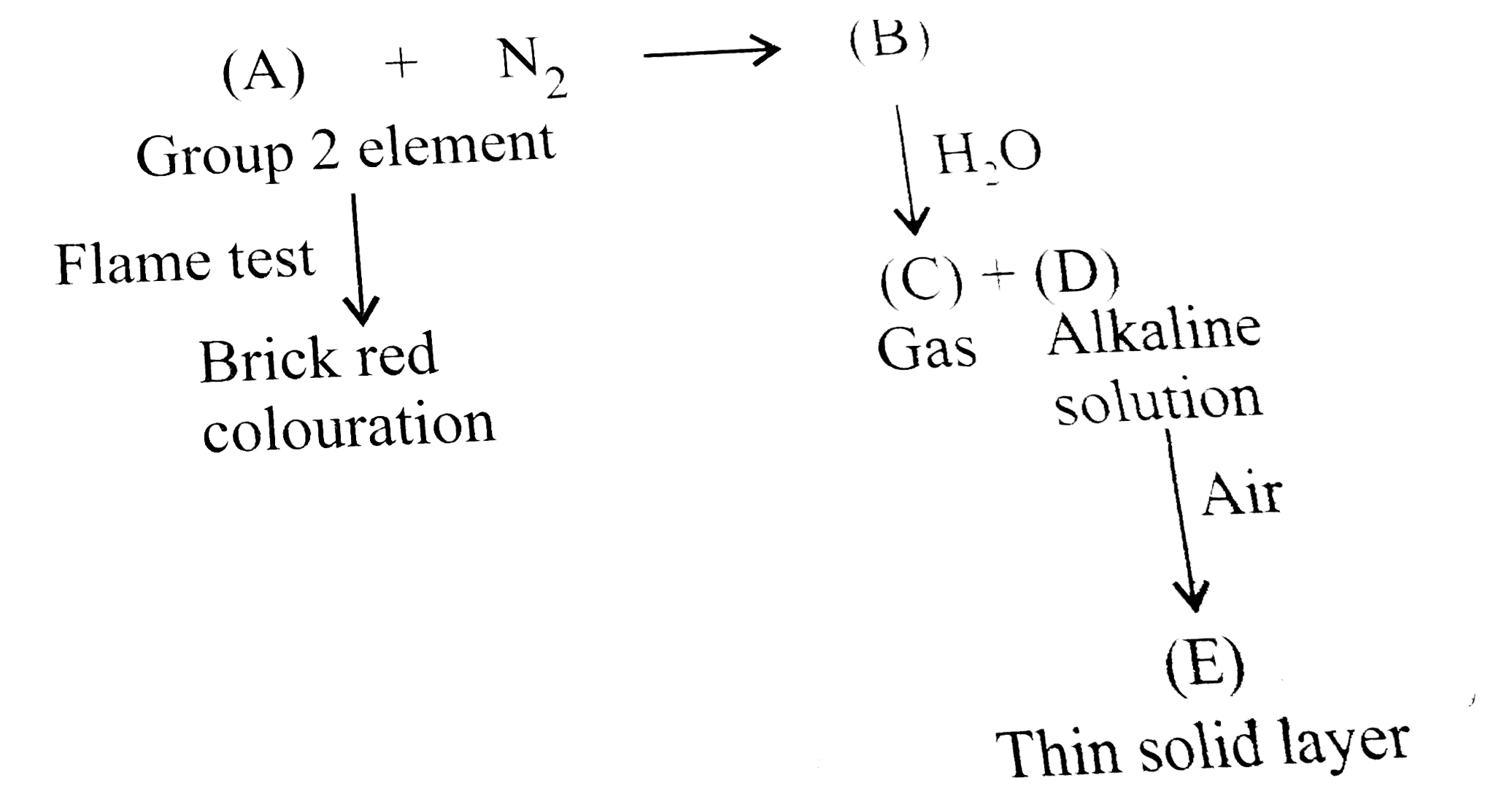An element (A) of group 2 gives brick red colour in the Bunsen flame. (A) burns in nitrogen atmoshphere to give (B), which gets hydrolysed to produce gas (C) and an alkaline solution (D). The solution (D) on exposure to air produces a thin solid layer (E) on the surface. Identify (A) to (E).

Since (A) gives brick red colouration in the bunsen flame, (A) is calcium.
3Ca(A)+N2→Ca3N2(B)(Calcium nitride)
Ca3N2+6H2O→3Ca(OH)2(D)+2NH3(C)
Ca(OH)2(D)+CO2(Air)→CaCO3(E)+H2O
Hence, (A) is calcium (Ca),(B) is Ca3N2,(C) is NH3,(D) is Ca(OH)2 and (E) is CaCO3.
Topper's Solved these Questions
- BOOK - CENGAGE CHEMISTRYCHAPTER - S-BLOCK GROUP 2 - ALKALINE EARTH METALSEXERCISE - Exercises Linked Comprehension42videos
S-BLOCK GROUP 2 - ALKALINE EARTH METALS
- BOOK - CENGAGE CHEMISTRYCHAPTER - S-BLOCK GROUP 2 - ALKALINE EARTH METALSEXERCISE - Exercises Multiple Correct25videos
S-BLOCK GROUP 2 - ALKALINE EARTH METALS
- BOOK - CENGAGE CHEMISTRYCHAPTER - S-BLOCK GROUP 2 - ALKALINE EARTH METALSEXERCISE - Ex 5.1 Objective2videos
S-BLOCK GROUP 2 - ALKALINE EARTH METALS
- BOOK - CENGAGE CHEMISTRYCHAPTER - S-BLOCK GROUP 1 - ALKALI METALSEXERCISE - Archives Subjective8videos
S-BLOCK GROUP 1 - ALKALI METALS
- BOOK - CENGAGE CHEMISTRYCHAPTER - SOME BASIC CONCEPTS AND MOLE CONCEPTEXERCISE - Archives Subjective11videos
SOME BASIC CONCEPTS AND MOLE CONCEPT
Similar Questions
Calcium burns in nitrogen a white solid which sufficient water to produce a gas (A) and an alkaline solution. The solution o nexposure to air produces a solid layer of (B) on the surface. Identify the compound (A) and (B).
View SolutionCalcium burns in nitrogen to produce a white powder which dissolves in sufficient water to produce a gas (A) and alkaline solution. The solution on exposure to air produce a thin solid layer of (B) on the surface. Indentity the compound (A) and (B)
View Solution
Knowledge Check
- Question 1 - Select One
An orange solid (A) on heating gives a green residue along with a gas (C ). (C ) on treatment with Mg gives a compounds (D) which hydrolyses to give a gas (E) which on reaction with K2HgI4 gives a ppt. An aq. Solution of (E) when passed through a solution of Hg2+ salt gives a ppt (F). The solution of (E) when passed through a solution of a metallic sulphide (M) white in colour gives a ppt which dissolves on addition of excess of (E).
The colour of ppt (F) isAblackByellowCBrownDorange
Calcium burns in nitrogen to produce a white powder which dissolves in sufficient water to produce a gas (A) and alkaline solution. The solution on exposure to air produce a thin solid layer of (B) on the surface. Indentity the compound (A) and (B)
View SolutionCalcium burns in nitrogen to produce a white powder which dissolves insufficient water to produce a gas A and an alkaline solution. The solution on exposure to air produces a thin solid layer of b on the surface. Indentify the compounds A and B.
View SolutionCalcium bums in nitrogon to produce a white powder which dissolves in sufficient water to produce a gas (A) and an alkaline solution. The solution on exposure to air produces a thin solid layer of (B) on the surface. Identify the compounds A and B.
View SolutionCalcium burns in nitrogen to produce a white powder which dissolve in sufficient water to produce a gas A and an alkline solution .The solution on esposure to air produces a this solid layer of B on the surface identify the compound A and B.
View SolutionA sulphide ore (A) on roasting leaves a residue (B). (B) on heating with chlorine gives (C), sulphide in water, addition of excess potassium iodide to a solution of (C) gives a solution (D) A brown precipitate (E) is formed when a solution of ammonium sulphate is added to an alkaline a solution of (D). Identify (A) to (E).
View SolutionA sulphide ore (A) on roasting leaves a residue (B). (B) on heating with chlorine gives (C), soluble in water, addition of excess potassium iodide to a solution of (C) gives a solution (D). A brown precipitate (E) is formed when a solution of ammonium sulphate is added to an alkaline solution of (D). Identify (A) to (E).
View Solutionalkali metal (A) on flame test gives a crimson red colour to the Busen flame. (A) on heating in air gives compound (C ) and gas (D). Gas (D) with Nessler's regent gives a brown precipitate Identify (A), (B), (C ) and (D).
View Solution

